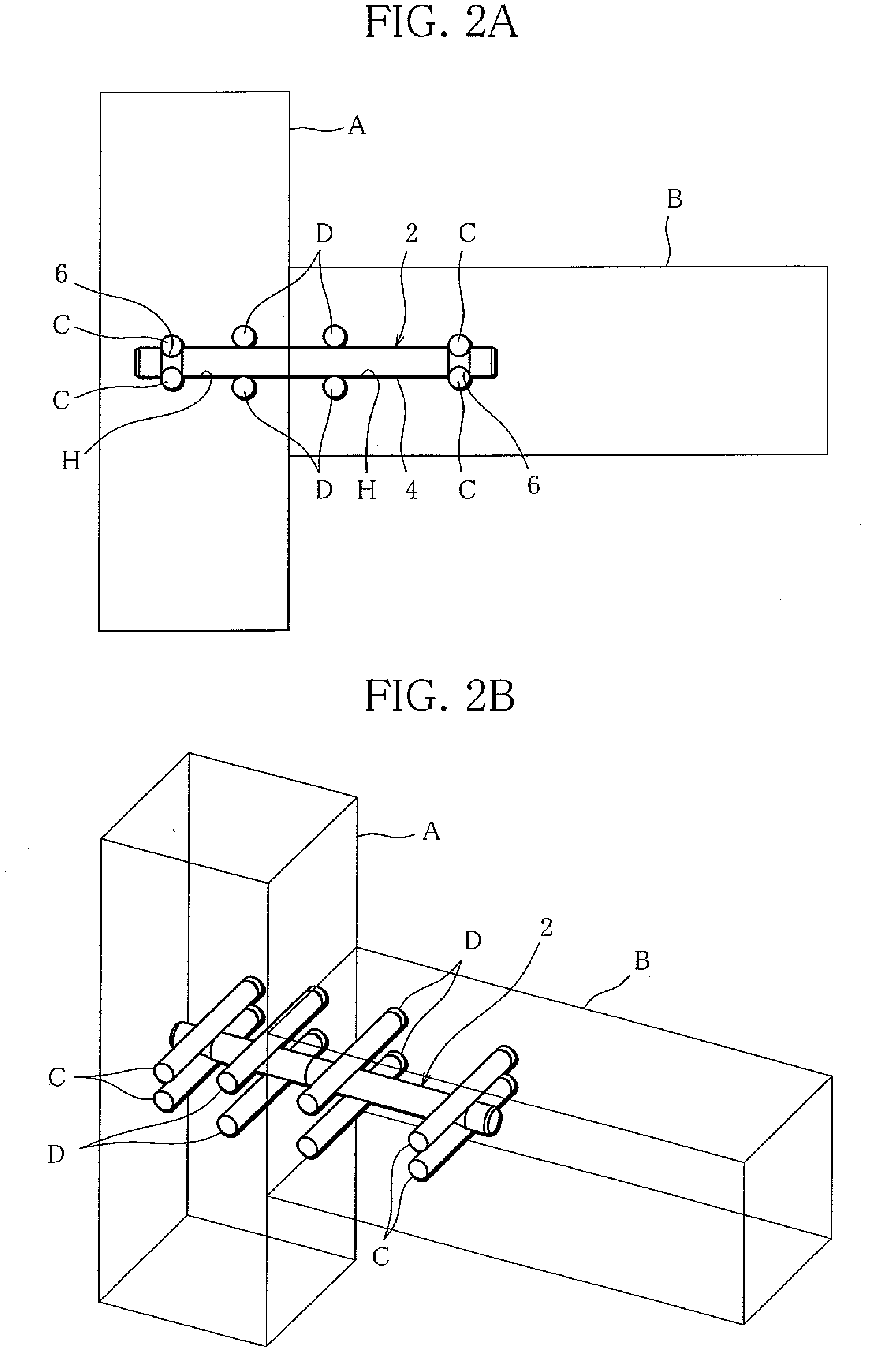Tenon Rod and Tenon Joint
- Summary
- Abstract
- Description
- Claims
- Application Information
AI Technical Summary
Benefits of technology
Problems solved by technology
Method used
Image
Examples
first embodiment
[0044]FIG. 1 shows a tenon rod 2 according to a
[0045]The tenon rod 2 includes a rod body 4 made of a metal round bar. The rod body 4 has an annular, or circumferential groove 6 in each end portion. The annular groove 6 is a circular arc in cross section, and extends all around the rod body 4. The annular groove 6 is intended to engage with the aforementioned pin, so-called drift pin.
[0046]FIGS. 2A and 2B show how to use the above-described tenon rod 2.
[0047]In FIG. 2, the tenon rod 2 and drift pins are used to join a post A and a beam B. The post A and the beam B are made of wood and each have a horizontally-extending mortise H to receive the tenon rod 2. The mortises H are arranged such that the post A and the beam B is in contact with each other, with their mortises' open ends met together.
[0048]Further, the post A and the beam B each have a plurality of pin insertion holes at specified locations. The pin insertion holes extend horizontally, across the mortise H, in pairs of an up...
second embodiment
[0069]FIG. 12 shows a tenon rod 2 according to a
[0070]In comparison with the tenon rod 2 in FIG. 3, the tenon rod 2 in FIG. 12 differs only in that it has a helical groove 16 in place of the annular groove 6. The helical groove 16 is a circular arc in cross section.
[0071]FIGS. 13A, 13B and 13C show how to use the tenon rod 2 of FIG. 12.
[0072]As seen from FIG. 13, the tenon rod 2 of FIG. 12 is inserted in a mortise H of a beam B, with the hexagonal head 8 projecting from the end face of the beam B. In this state, a pair of drift pins C are fitted in the spiral groove 16 on the upper and lower sides of the tenon rod 2 to hold the tenon rod 2 between them. Due to the helical configuration of the helical groove 16, the drift pins C are at different axial locations with respect to the tenon rod 2. FIG. 13 also shows a drift pin D and a drift pin J. The drift pin D is set in contact with the cylindrical surface of the rod body 4 as mentioned above, while the drift pin J is fitted in the h...
third embodiment
[0100]FIG. 25 shows a tenon rod 2 according to a
[0101]The tenon rod 2 of FIG. 25 has a helical groove 16 in a first end portion of the rod body 4, an annular groove 6 in the opposite, second end portion thereof, and a hexagonal tail 14 at the second end of the rod body 4.
[0102]FIGS. 26A, 26B and 26C show how to use the tenon rod 2 of FIG. 25.
[0103]As seen from FIG. 26, the tenon rod 2 of FIG. 25 is used to join a beam B to a post A.
[0104]FIG. 27 shows a variant of the tenon rod according to the third embodiment.
[0105]The tenon rod 2 of FIG. 27 differs from the tenon rod of FIG. 25 only in that it has a hexagonal hole 15 in place of the hexagonal tail 14.
[0106]FIGS. 28 to 30 show a tenon joint according to an embodiment.
[0107]The tenon joint comprises a tenon rod 30 shown in FIG. 28 and a drift pin 32 shown in FIGS. 29A, 29B and 29C.
[0108]The tenon rod 30 has an annular groove 6 in a first end portion of a rod body 4, and the opposite, second end portion of the rod body is formed int...
PUM
 Login to View More
Login to View More Abstract
Description
Claims
Application Information
 Login to View More
Login to View More - R&D
- Intellectual Property
- Life Sciences
- Materials
- Tech Scout
- Unparalleled Data Quality
- Higher Quality Content
- 60% Fewer Hallucinations
Browse by: Latest US Patents, China's latest patents, Technical Efficacy Thesaurus, Application Domain, Technology Topic, Popular Technical Reports.
© 2025 PatSnap. All rights reserved.Legal|Privacy policy|Modern Slavery Act Transparency Statement|Sitemap|About US| Contact US: help@patsnap.com



